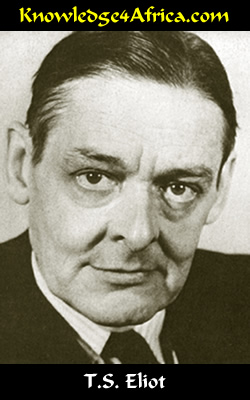|
READ THIS
The poem commemorates a breakup with a young woman who is deeply hurt by the experience. But is
this young woman real or imaginary? Indeed, is the breakup itself real or imaginary? There are many
clues in the poem who could lead us to conclude either way.
 ABOUT THE POET
ABOUT THE POET
Thomas Stearns Eliot was born in St Louis (Missouri) in 1888. He attended Harvard University and
graduated with a Masters degree in Philosophy. While there, he published several poems in the
Harvard Advocate.
The poet left the United States in 1910, moving first to France, then Germany and finally London. He
married Vivienne Haigh-Wood in 1915, which caused him to settle permanently in England. His marriage
was never successful, however, and they separated in 1933. In 1956 he would remarry, this time to
Valerie Fletcher.
Early during his stay in London, Eliot fell under the influence of the great American poet, Ezra Pound, who
also assisted in the publication of his early work.
The publication of his first book of poetry - Prufrock and Other Observations, 1917 - revealed
Eliot as a forerunner of what is known as "Modernism", the philosophy of Modern Art. His next book -
The Waste Land, 1922 - is claimed by many to contain some of the most important poetry of the
20th century.
Eliot was awarded the Nobel Prize for Literature in 1948. He died in London in 1965. He was 77 years
old.
Have you looked at the questions
in the right column?
|
TEST YOURSELF!
Read the left column and then answer
the following questions:
Let's start off with two basic questions:
- What does the title of this poem ("La Figlia Che Piange") mean? (2)

[Need help?]
The title is Italian and means "the young girl weeping".
|
- What does the sub-title ("O quam te memorem virgo") mean? (2)

[Need help?]
The sub-title is Latin and it means "O Virgin, how must I address you?" It's a quote from Virgil's poem,
The Aeneid.
In this poem, Aeneas meets his mother, Venus, but she is disguised as a hunter and he fails to recognise
her. Nevertheless, he thinks she is a goddess and therefore needs to know the correct way to address
her. (How would you address a goddess if you accidentally met one?)
|
- Is the woman he is addressing real or is she imaginary? (4)

[Need help?]
She's a little of both, I'm afraid, and that's what makes this poem complicated.
It would seem the Eliot did have a woman in mind, although even in his mind she might have been
imaginary. Indeed, this poem is quite literally a painting-in-words and, although the poet might have had
a model in mind, the end product is the painting.
This is further complicated by the fact that friends had apparently told the poet to have a look at a
particular stele called "La Figlia Che Piange" in a museum in Northern Italy. This is a stone or
wooden slab or piece of sculpturing, usually to commemorate a dead person.
The poet went to the museum but he didn't see the stele. Instead, he wrote this poem. Hence the
question: is this poem his version of the stele and therefore a commemoration of another
commemoration? Or is he using the idea of the stele to commemorate a breakup with a real woman, or
one in his own imagination?
You decide.
|
Have a read of the entire poem several times. It is written in three stanzas but each appears to be
different. Indeed, the subject of each stanza differs. This is indicated by the personal pronouns which
the poet uses in each. Would you like to comment? (10)

[Need help?]
Stanza 1 would appear to be directing the young woman as a director of a play or movie would do. He
tells her where to stand, how to move, what to do, where to look.
Stanza 2 is more personal. Note the continuous use of the personal pronoun "I". This verse is therefore
from the poet's own point of view, expressing how he would have liked the breakup to happen.
Stanza 3 would appear to be a more reflective verse, composed some time after the breakup. It appears
to capture some of the emotional sentiment which has seized the poet once he has had time to reflect
upon the situation.
|
"O quam te memorem virgo" ("O Virgin, how must I address you?")
- Why would the poet begin his poem with these words? (10)

[Need help?]
Eliot is one of those thinking poets. And he expects the reader to think when reading his poetry. He would
want us at the very least to know where he took this quote and what it means.
Essentially, therefore, the poet is posing this question: my painting-in-words concerns a breakup. But
how do I address this breakup? From her angle? From my own angle? Or perhaps from the angle of
a third party who might or might not know what is going on?
As a painting-in-words, what brush strokes do I use? Do I present this breakup as if it were a play I am
producing, where the actions, postures, etc, are all important? Or do I take it that the woman is mean and
nasty, and deserves everything that she gets? Or perhaps she is innocent?
"Oh virgin poem, how must I address you?" What do you think?
|
"Stand on the highest pavement of the stair -
Lean on a garden urn -
Weave, weave the sunlight in your hair -
Clasp your flowers to you with a pained surprise -
Fling them to the ground and turn
With a fugitive resentment in your eyes:
But weave, weave the sunlight in your hair."
- The poet is presenting these lines clearly as if he were directing a play, directing the woman's actions.
But what would be the purpose of his twice instructing her to "weave the sunlight in her
hair"? (4)

[Need help?]
All the instructions deal with where she should stand, how she should look, what she should be doing.
The end product, however, must be a work of art. This is more than just a poem about a breakup. It's
a painting-in-words. It's a work of art.
The poet is therefore also looking for the aesthetic quality. Weaving the sunlight in her hair is that
aesthetic quality. It conjures up not only action but a certain magical quality of sunlight shining off her hair.
|
- The poet uses the word "weave" no less than four times in this stanza. Why? (4)

[Need help?]
The word "weave" is, of course, associated with the art of weaving but it conjures up more than this.
Indeed, there is a sense of magic about the word, a sense of the fantasy or fairy tale. There is the damsel
weaving strands of her hair on the magical loom to produce the finest gold.
It must surely be this that the poet is attempting to conjure up: a magical, mystical quality to his poem.
In other words, a work of art.
|
- Would it matter much in real life if the breakup is presented as a work of art? (4)

[Need help?]
Well, yes. If the breakup is presented as a work of art, it certainly lessens the blame, the responsibility.
The breakup itself even becomes something of value. Ask Adele.
What do you think?
|
- When the poet instructs the woman to clasp her flowers to her breast with a pained surprise and then
to fling them to the ground, what emotions does this portray? (4)

[Need help?]
There's certainly anger here, isn't there? She must fling the flowers to the ground in anger. Or
is it feigned anger? What does the "pained surprise" portray? Hurt? Or feigned hurt?
What is going on here? This poem is filled with reasonable interpretations? Is there any truth to be found
anywhere? Or is this entire breakup something which is feigned? True or false? You decide.
And that is precisely T.S. Eliot's philosophy. Once the poem has been written, it ceases to be the
interpretation of the poet but now becomes the interpretation of the reader. What does the reader think?
|
- The poet speaks of "a fugitive resentment" in her eyes. Why would the resentment be
"fugitive"? (4)

[Need help?]
Once more we are presented with a scenario which might be real but might also be fake. She has
"resentment", right - but it appears to be false, to be running away, to be difficult to hold onto.
|
|



